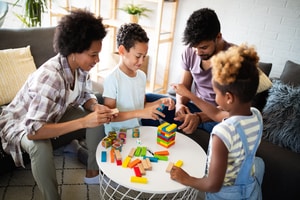Chiropractic and Myotherapy: Relieving Pain and Restoring Mobility in Kids
Children often encounter a variety of aches and pains, whether from sports activities, playing, or everyday growth spurts. Chiropractic care and myotherapy offer non-invasive methods to address these issues, focusing on the musculoskeletal system. These therapies aim to relieve pain and restore mobility, ensuring that children can continue their activities with ease.
Chiropractic involves gentle adjustments to align the spine and improve overall function, enhancing a child’s well-being. Myotherapy complements this by targeting specific muscle groups, alleviating tension and promoting recovery. Together, these approaches create a holistic path to improved health and vitality for young ones.
Parents considering these treatments for their children often find they provide a supportive environment that prioritizes individual needs. With personalized care plans, chiropractic and myotherapy offer effective solutions, contributing positively to a child’s daily life and long-term health.
Parents considering these treatments for their children often find they provide a supportive environment that prioritizes individual needs, with options like local chiropractors offering expert care to help alleviate pain and improve mobility.
Understanding Chiropractic Care
Chiropractic care focuses on manual techniques to enhance spinal alignment and alleviate discomfort. This approach benefits children by addressing specific growth and development challenges.
History and Philosophy of Chiropractic
Chiropractic care emerged in the late 19th century with the idea that proper spinal alignment plays a crucial role in overall health. Founder Daniel David Palmer believed that spinal adjustments could directly impact bodily functions. Chiropractic philosophy emphasizes the body’s ability to heal itself when the spine is properly aligned.
This holistic approach has evolved, especially in pediatric care, incorporating evidence-based practices. Integration of scientific research has helped refine methods to ensure safety and effectiveness. Understanding the origins and philosophy behind chiropractic care provides a foundational knowledge for evaluating its role in children’s health.
Chiropractic Techniques for Children
Chiropractors use gentle techniques specifically designed for children, considering their developing bodies. These methods often require less force than those used on adults. Techniques may include soft tissue therapy, cranial adjustments, and spinal mobilization.
Pediatric chiropractors aim to enhance mobility and reduce discomfort without causing additional strain. Practitioners prioritize gentle pressure to address issues like colic, back pain from poor posture, and mobility challenges. Each session is tailored to the child’s unique needs, promoting healing in a supportive and non-invasive way.
Safety and Efficacy in Pediatric Care
Safety in pediatric chiropractic care is a top priority. Practitioners are trained to assess each child’s suitability for the treatment and to apply techniques appropriately. Research indicates that chiropractic care can safely support musculoskeletal health in children. However, it is crucial for parents to choose qualified professionals with pediatric expertise.
While serious complications are rare, discussing concerns with both a chiropractor and a pediatrician ensures comprehensive care. Families often report positive experiences with chiropractic methods, citing reduced pain and improved mobility. Thorough training and an understanding of child development contribute to the efficacy and safety of chiropractic interventions.
Myotherapy and Its Role in Child Health

Myotherapy is essential in addressing muscular discomfort in children and promotes better mobility. This part explores its core principles and advantages for young patients.
Fundamentals of Myotherapy
Myotherapy centers on assessing, treating, and managing pain related to soft tissue and muscle issues. It incorporates hands-on techniques like massage, trigger point therapy, and stretching to alleviate discomfort.
In children, myotherapy targets specific muscle groups that may be affected by injuries, growth spurts, or muscular imbalances. Practitioners perform detailed evaluations to tailor treatments to the child’s needs, fostering a holistic approach to health.
A myotherapist may collaborate with healthcare providers to create comprehensive care plans, ensuring that all aspects of a child’s health are considered. This collaboration is integral to effective treatment.
Benefits of Myotherapy for Children
Myotherapy offers several advantages for children experiencing muscular pain or discomfort. It helps reduce pain, improves flexibility, and increases mobility. This can be particularly beneficial for children with growing or developing bodies that experience stress from sports or daily activities.
Parents often notice reduced tension and enhanced well-being in their children following sessions. The therapy can also aid in preventing future injuries by teaching children beneficial exercises and educating them on posture and body awareness.
Children participating in myotherapy may experience improved physical performance and comfort in their daily activities. The targeted approach allows young patients to enjoy active lifestyles without discomfort or restriction.
Diagnosing Musculoskeletal Issues in Children
Identifying musculoskeletal problems in children involves recognizing conditions specific to young patients and employing appropriate assessment techniques. Proper diagnosis is crucial for effective treatment and management of these issues.
Common Childhood Musculoskeletal Conditions
Children can experience a range of musculoskeletal conditions, some of which include scoliosis, growing pains, and juvenile arthritis. Scoliosis, a curvature of the spine, often becomes noticeable during growth spurts. Early detection is key to preventing more significant spinal deformities.
Growing pains usually affect children between the ages of 3 and 12, characterized by leg pain, typically at night. Though uncomfortable, these pains are generally harmless and self-limiting.
Juvenile arthritis can manifest as joint inflammation and stiffness, sometimes leading to reduced mobility. Prompt medical attention is important to manage symptoms and prevent joint damage. Flat feet can also be present in children, often resolving naturally with age, but it might require intervention if persistent pain occurs.
Assessment Techniques
Healthcare professionals use various techniques to assess musculoskeletal issues in children. Physical examinations are essential, where doctors observe posture, gait, and range of motion. Palpation helps identify tenderness or abnormalities in muscle or bone structure.
Imaging techniques, such as X-rays or MRI scans, are employed to gain a detailed view of any structural issues. These tools help visualize the extent of scoliosis or detect changes caused by juvenile arthritis.
Functional assessments, including balance and coordination tests, evaluate the child’s motor skills and overall physical function. Gathering a detailed family medical history and conducting thorough interviews provides additional context for a precise diagnosis. This comprehensive approach ensures accurate identification and effective management of musculoskeletal conditions in children.
Treatment Approaches and Techniques
Chiropractic and myotherapy offer specialized techniques to help children manage pain and improve mobility. These approaches are designed to address specific issues safely and effectively.
Chiropractic Adjustments for Kids
Chiropractic adjustments for kids focus on gentle techniques to ensure safety and comfort. Practitioners often use instruments or their hands to apply precise force to targeted areas. This can help realign the spine, improve posture, and relieve tension.
Adjustments may be beneficial for children experiencing pain from sports injuries, accidents, or developmental issues. It is essential for chiropractors, including those practicing the Gonstead chiropractic treatment method, to conduct thorough assessments before treatment to tailor the approach to the child’s needs. Accident clinics often refer children for chiropractic care as part of a comprehensive treatment plan.
Myotherapy Methods and Practices
Myotherapy involves therapeutic techniques such as massage and trigger point therapy to alleviate muscle tension in kids. Practitioners identify and treat specific muscle groups that contribute to pain or restricted movement. This is particularly useful for children with muscle tightness due to activity or postural imbalances.
Sessions typically include stretching exercises, which are important for improving flexibility and mobility. Therapists might also incorporate tools like foam rollers for added effectiveness. It is crucial for the methods used to be age-appropriate and suitable for a child’s specific condition. Visiting a well-equipped clinic can ensure access to these tailored treatments.
Relieving Pain and Restoring Mobility
Chiropractic and myotherapy play crucial roles in helping children overcome pain and enhance their physical abilities. They provide targeted approaches to address both acute and chronic discomfort, while also focusing on improving movement through tailored therapy.
Managing Acute and Chronic Pain
Chiropractors and myotherapists use a variety of techniques to manage pain. For acute pain, such as injuries from sports or play, they often employ gentle manipulation and soft tissue therapies. Ice and heat treatments are frequently applied to reduce inflammation and discomfort.
In chronic pain cases, a comprehensive approach is adopted. Techniques like trigger point therapy, stretching, and massage are used consistently. These approaches help reduce muscle tension and promote long-term relief. Custom exercises may also be part of the treatment plan to improve strength and prevent recurrence.
Improving Mobility Through Therapy
Enhancing mobility is key to ensuring children maintain an active lifestyle. Therapists focus on joint health and flexibility through targeted exercises. These activities are designed to suit the child’s age and ability, ensuring they are both effective and safe.
Stretching routines are implemented to increase flexibility and range of motion. Balance exercises strengthen core muscles and support better posture. Regular assessments and adjustments help track progress and make necessary changes to the therapy plan.
Through dedicated care, the goal is to restore optimal movement and physical function, allowing children to engage fully in their favorite activities.
Preventive Strategies and Lifestyle Advice
Implementing effective preventive strategies and maintaining a balanced lifestyle can significantly enhance children’s musculoskeletal health. Addressing injury prevention, as well as fostering proper nutrition and exercise habits, is crucial.
Injury Prevention Education
Educating children about injury prevention is vital. Teaching them the importance of safe play and awareness of their surroundings can reduce the risk of accidents. Wearing protective gear, such as helmets and pads, during sports or biking is essential.
Adults should regularly inspect playgrounds and sports equipment to ensure safety standards are met. Supervising playtime, coupled with teaching appropriate techniques for lifting and carrying objects, helps safeguard children’s physical health.
Clear communication about the importance of warm-up exercises and cool-down routines before and after physical activities or sports is crucial. This practice can minimize the risk of strains and sprains. Reinforcement through regular reminders and visual aids like posters can be effective.
Nutrition and Exercise for Musculoskeletal Health
Proper nutrition supports musculoskeletal development. Encouraging a diet rich in calcium, vitamin D, and protein is important for healthy bones and muscles. Dairy products, leafy greens, and lean meats can be beneficial.
Incorporating regular exercise helps maintain flexibility and strength. Activities like swimming, yoga, or simple stretching exercises can be enjoyable and beneficial for children. Designing an exercise routine that includes both aerobic and strength-training workouts is suggested.
Limiting screen time and promoting outdoor play can enhance physical activity levels. Parents and caregivers can serve as role models by demonstrating active lifestyles, making exercise a family routine to instill healthy habits early on.
Accident and Injury Rehabilitation
Chiropractic and myotherapy can play crucial roles in children’s recovery after accidents. They focus on restoring mobility and alleviating pain through targeted therapies.
Post-Accident Recovery Pathways
Accident recovery for children often begins at an accident clinic where initial assessments are made. These evaluations help determine the severity and specific nature of injuries. Key components of effective recovery pathways include tailored treatment plans and continuous monitoring.
In many cases, a combination of physical therapy, chiropractic adjustments, and myotherapeutic techniques is employed. This multifaceted approach helps address pain and improve function. Sessions are usually structured to allow gradual increase in movement abilities while minimizing discomfort.
Parental involvement is encouraged to ensure compliance and support at home. Regular communication between healthcare providers and families is essential, fostering a collaborative approach. Follow-ups help in tracking progress and adapting interventions.
Integrating Chiropractic and Myotherapy in Rehabilitation
Chiropractic care and myotherapy can complement traditional rehabilitation methods effectively. Chiropractic adjustments focus on spinal alignment, which can relieve pain stemming from nervous system disruptions. These adjustments can aid in quicker recovery by enhancing the body’s natural healing process.
Myotherapy complements these efforts by targeting soft tissue. Techniques such as deep tissue massage and trigger point therapy are used to address muscle tightness and stiffness. This can restore mobility and reduce inflammation.
Both disciplines prioritize non-invasive techniques and work towards minimizing the need for medication. Practitioners often emphasize holistic approaches, considering lifestyle changes and ergonomic adjustments. Collaboration between chiropractors, myotherapists, and other medical professionals optimizes treatment plans and outcomes.
Case Studies and Success Stories
Chiropractic and myotherapy have shown positive impacts on children’s health, addressing issues ranging from discomfort to limited mobility. Through specific interventions, both disciplines have offered promising results in improving children’s conditions.
Pediatric Case Studies
In several cases, children suffering from conditions like scoliosis and chronic pain have seen improvements.
Case Example: A 10-year-old with mild scoliosis underwent a series of chiropractic adjustments. After several months, there was noticeable curvature improvement.
Another case involved a 7-year-old with frequent headaches. Chiropractic care reduced the frequency and intensity of these headaches within weeks, contributing to a better quality of life.
Additionally, myotherapy has proven beneficial. A child with muscular dystrophy symptoms experienced increased flexibility and reduced muscle pain after consistent myotherapy sessions. These examples highlight the tangible benefits of these therapies in pediatric care.
Testimonials from Parents and Children
Parents often note the positive changes in their children’s health post-treatment. One mother reported that her son’s back pain significantly decreased after chiropractic sessions. He became more active without experiencing discomfort.
Feedback from a Child: An 8-year-old described how myotherapy sessions made soccer practice more enjoyable, as muscle stiffness diminished.
Children’s testimonials support the notion that these therapies not only relieve pain but also enhance daily activities. Such feedback underscores the potential of chiropractic and myotherapy in providing effective, non-invasive treatment options for young patients.










